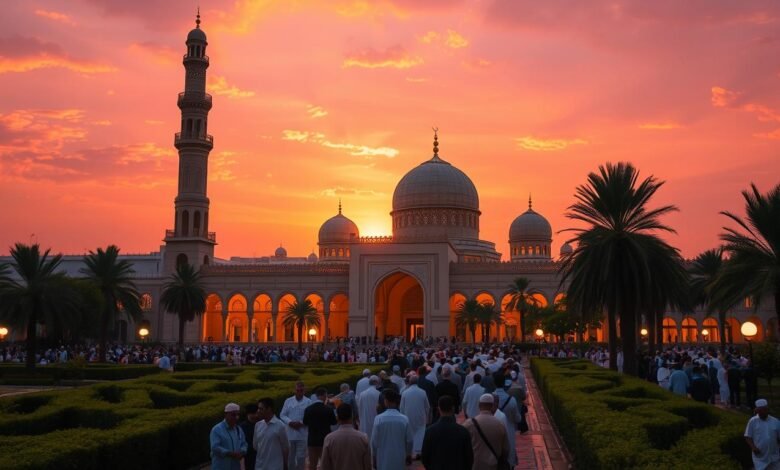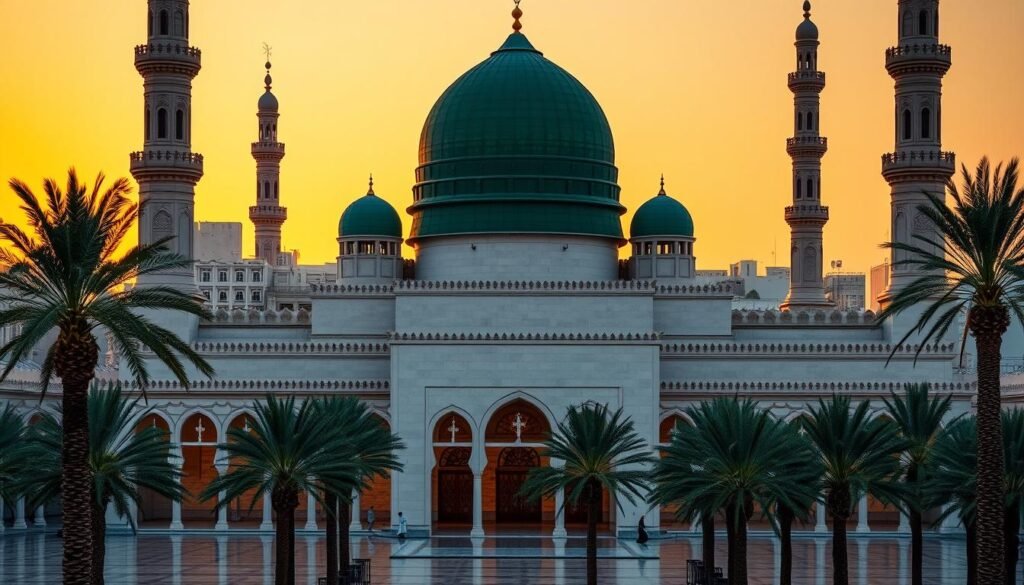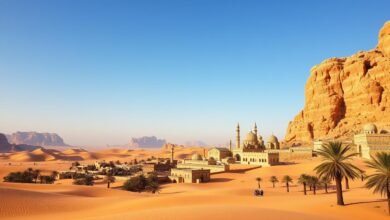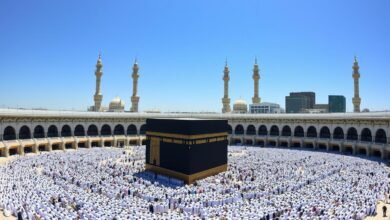Sacred Experiences: Visiting the Prophet’s Mosque in Medina

Have you ever thought about visiting a place deeply meaningful to millions of Muslims? The Prophet’s Mosque, or Masjid al-Nabawi, in Medina is such a place. As I get ready for this journey, I’m curious: What transformative experiences await those who step into this historic mosque?
The Prophet’s Mosque is more than a place of worship. It’s a symbol of Islam’s rich history and spiritual legacy. Starting as a simple structure by the Prophet Muhammad, it has grown over time. Each part of its history promises a deep connection with the enduring spirit of Islam.
I’m filled with reverence and excitement for my visit to the Prophet’s Mosque. What secrets will its ancient walls share? What moments of transformation will I find in its peaceful, spiritual air? Walking in the Prophet Muhammad’s footsteps and feeling history’s echoes is both humbling and thrilling.
Understanding the Historical Significance of Masjid al-Nabawi
In the heart of Medina, the Masjid al-Nabawi, or the Prophet’s Mosque, is deeply significant. It was founded by Prophet Muhammad. It became a key part of the early Muslim community and a symbol of faith growth.
The Prophet’s Role in Establishing the Mosque
When Prophet Muhammad arrived in Medina in 622 CE, he knew a central place of worship was needed. He built the first mosque, a simple structure made of palm fronds and mud bricks. This humble start led to the magnificent mosque we admire today.
Evolution Through Islamic Dynasties
Through the ages, the Masjid al-Nabawi has seen the rise and fall of Islamic dynasties. Each, from the Umayyads to the Ottomans, has added to its beauty. Their contributions have enriched this cultural site.
Architectural Expansions Over Centuries
The mosque has grown and changed over time, becoming larger and more beautiful. It now boasts domes, minarets, and detailed decorations. These changes show the Islamic world’s rich history and artistic skill.
Today, Masjid al-Nabawi is a symbol of Medina’s cultural heritage. It attracts millions of visitors worldwide. They come to experience its sacred atmosphere and learn about the Islamic faith’s history.
Planning Your Journey to the Prophet’s Mosque
Traveling to the Prophet’s Mosque in Medina, Saudi Arabia, is a deep spiritual journey. To make your visit smooth and memorable, plan carefully. This includes getting the right visa and finding good places to stay.
Obtaining the Appropriate Visa
To visit Saudi Arabia and the Prophet’s Mosque, you need the right visa. You can choose from Umrah or Hajj visas for religious tourism. Make sure to research and apply early to avoid any issues.
Accommodation Options
Medina has many places to stay, from fancy hotels to budget-friendly options. Book early, especially during busy times, to get the best deals.
Timing Your Visit
- The best time to visit the Prophet’s Mosque is during Umrah and Hajj seasons. This is when the mosque is most lively and spiritual.
- But, be aware of the busy seasons. They can be crowded and more expensive.
- Visiting in the off-season can be quieter and cheaper.
| Season | Advantages | Disadvantages |
|---|---|---|
| Peak Umrah and Hajj | Vibrant spiritual atmosphere, opportunity to participate in major Islamic rituals | Increased crowds, higher prices for accommodations and transportation |
| Off-season | Less crowded, more affordable accommodations and transportation | Fewer opportunities to participate in major Islamic rituals |
By thinking about these points, you can plan a great trip to the Prophet’s Mosque in Medina. This will make your religious tourism in Saudi Arabia unforgettable.
Sacred Experiences: Visiting the Prophet’s Mosque in Medina
Going on an Islamic pilgrimage to the holy sites is a deep and changing experience. The Prophet’s Mosque, or Masjid al-Nabawi, in Medina is a treasured spot. As you get close, the tall minarets against the sky fill you with awe and hope.
First Glimpse of the Minarets
The green-domed mosque and its shiny minarets are breathtaking. This beautiful building shows the rich Islamic culture. Seeing it for the first time stirs deep feelings, starting a journey of change for all who visit.
Entering the Sacred Grounds
When you walk through the gates into the Prophet’s Mosque, a calm washes over you. The city’s noise disappears, leaving only peace and respect. The fancy archways and detailed calligraphy on the walls remind you of the site’s deep history and importance.
Spiritual Atmosphere Inside
Inside the Prophet’s Mosque, you can feel the spiritual vibe. The air is filled with Quran recitation, prayer chanting, and quiet prayers. This creates a peaceful atmosphere, letting visitors feel close to the divine. It’s a moment that goes beyond time and space, linking people to the Prophet Muhammad and Islamic tradition.

The Architecture and Design of Masjid al-Nabawi
Masjid al-Nabawi, the Prophet’s Mosque in Medina, is a masterpiece of sacred architecture. It shows the rich cultural heritage of Islamic civilization. The mosque’s design and decorations reflect Islamic art’s power to inspire spiritual feelings.
The mosque’s iconic minarets guide worshippers to the sacred space. These tall, elegant structures are covered in beautiful calligraphy and geometric patterns. They show the Islamic focus on visual faith expression.
The mosque’s large domes, some covered in gold, stand out from afar. These domes add to the building’s beauty and symbolize its cultural importance.
The mosque’s interior is stunning, with detailed tile work, ornate columns, and beautiful chandeliers. These elements create a peaceful and visually stunning space. It invites visitors to dive into the sacred atmosphere.
Exploring the mosque shows its architecture reflects Islamic cultural and artistic traditions. The calligraphy and geometric patterns highlight the creativity and skill of the builders. They have shaped the mosque over the centuries.

The architectural wonders of Masjid al-Nabawi amaze visitors and remind us of the importance of preserving cultural heritage. This iconic mosque is a symbol of faith, art, and history. It invites everyone to experience the Islamic sacred experience.
Exploring the Different Areas Within the Mosque
The Masjid al-Nabawi, or the Prophet’s Mosque, in Medina is a vast and remarkable Islamic holy site. It holds immense religious and historical significance for the Muslim community. As you step inside, you’ll be captivated by the diverse and intriguing areas that make up this iconic mosque.
Rawdah: The Garden of Paradise
The Rawdah, also known as the “Garden of Paradise,” is one of the most revered areas. It’s believed to be a part of Paradise, where the Prophet Muhammad himself walked and prayed. Visitors can experience a profound sense of spiritual connection as they stand within this blessed area.
They are surrounded by the serene atmosphere and vibrant green gardens.
The Historic Pillars
As you explore the Masjid al-Nabawi, you’ll see the historic pillars. These ancient structures, some dating back to the era of the Prophet Muhammad, serve as a tangible link to the mosque’s rich heritage. Each pillar holds a unique story, capturing the evolution of the Masjid al-Nabawi through the ages.
They show the various Islamic dynasties that have left their mark on this revered site.
Prayer Halls and Courtyards
The Masjid al-Nabawi boasts expansive prayer halls and courtyards. These vast and meticulously designed spaces can accommodate thousands of worshippers during peak seasons. They are a testament to the architectural prowess of the Muslim communities that have cherished and maintained this holy site over the centuries.
Visitors can immerse themselves in the serene atmosphere. They can observe the devotion of the faithful as they engage in prayer and spiritual contemplation.
Exploring the diverse areas within the Masjid al-Nabawi is a profound and enriching experience. It allows visitors to connect with the rich history and spiritual essence of this iconic Muslim holy site.
Etiquette and Guidelines for Visitors
Going on the Islamic pilgrimage to the Prophet’s Mosque in Medina is a deeply spiritual journey. It’s important to respect the mosque’s sanctity by following certain rules. These customs help you make the most of your visit and connect deeply with this sacred place.
First, dress modestly when you visit the Prophet’s Mosque. Men should wear long pants and shirts that cover their shoulders. Women should wear loose, flowing clothes that cover their heads, arms, and legs. Avoid shorts, sleeveless tops, or anything that might be seen as disrespectful.
Second, be calm and respectful during your time at the mosque. Don’t make loud noises or laugh too much. Speak softly and be mindful of others who might be praying or reflecting.
- Avoid eating or drinking in the mosque’s main prayer halls.
- Don’t take photos or videos inside the mosque, as it’s usually not allowed.
- Listen to the mosque staff and security. They help keep everyone safe and comfortable.
By following these guidelines, your visit to the Prophet’s Mosque will be a meaningful and enriching experience. It will honor the Prophet Muhammad and the mosque’s sacredness.
Best Times to Visit and Prayer Schedules
Visiting the Prophet’s Mosque in Medina can be a life-changing experience. To get the most out of your trip, timing is key. Knowing the mosque’s prayer times is also crucial.
Peak Seasons and Quiet Periods
The Prophet’s Mosque gets busier at certain times of the year. This includes major Islamic holidays like Ramadan and Eid al-Fitr. During these periods, the mosque is packed with people from all over the world.
However, the summer months and shoulder seasons are usually quieter. These times offer a calmer and more reflective experience. It’s easier to connect with the sacred atmosphere of Masjid al-Nabawi.
Daily Prayer Timings
| Prayer | Timing |
|---|---|
| Fajr (Dawn) | 4:30 AM |
| Dhuhr (Noon) | 12:30 PM |
| Asr (Afternoon) | 3:30 PM |
| Maghrib (Sunset) | 6:15 PM |
| Isha (Night) | 7:45 PM |
It’s important to keep track of the daily prayer times. The mosque might have restricted access or more activity during these hours. Planning your visit around these times can make your experience better and more meaningful.
Surrounding Areas and Religious Sites
Medina’s rich culture goes beyond the Prophet’s Mosque. The city has many important landmarks and sites that show Islamic history and spirituality. Places like the Quba Mosque, the first built by Prophet Muhammad, and Jannat al-Baqi cemetery are worth seeing.
The Masjid al-Qiblatayn is a key site. It’s where Prophet Muhammad was told to change prayer direction from Jerusalem to Mecca. The Masjid al-Ghamama is also important, as it’s where Prophet Muhammad gave the first Eid prayer.
Don’t miss the markets and streets of Medina. The Suq al-Qaysariyyah market shows the city’s trade and commerce. The Bab al-Jum’ah gate is a beautiful entrance to the Prophet’s Mosque. These places make the pilgrimage experience richer and more meaningful.
FAQ
What is the significance of the Prophet’s Mosque in Medina?
The Prophet’s Mosque, also known as Masjid al-Nabawi, is very important in Islam. It’s the second most sacred mosque after the Masjid al-Haram in Mecca. It was built by Prophet Muhammad and is where he is buried.
What is the history behind the Prophet’s Mosque?
Masjid al-Nabawi was started by Prophet Muhammad in 622 CE. He moved to Medina and built the mosque. Over time, it has grown and changed, showing the rich history of Islam.
What should I know when planning a visit to the Prophet’s Mosque?
Planning a visit to Masjid al-Nabawi requires knowing about visas, travel, and where to stay in Medina. It’s also important to learn about visitor etiquette to have a respectful experience.
What is the spiritual experience like when visiting the Prophet’s Mosque?
Visiting the Prophet’s Mosque is deeply spiritual. Seeing the minarets and entering the sacred grounds feels reverent. It connects you to the mosque’s history and religious importance.
What are the architectural highlights of the Prophet’s Mosque?
The Prophet’s Mosque is known for its stunning architecture. It showcases Islamic art and culture. Features include beautiful minarets, domes, and prayer areas that create a peaceful atmosphere.
What are the different areas and significant sites within the Prophet’s Mosque?
The mosque has many important areas, like the Rawdah and historic pillars. There are also prayer halls and courtyards. Exploring these areas helps you understand the mosque’s significance.
What are the best times to visit the Prophet’s Mosque?
The best times to visit depend on what you want. Busy times are during Islamic holidays, while quieter times are better for reflection. Knowing the prayer times helps plan your visit.
What other religious and historical sites can I explore around the Prophet’s Mosque?
Medina has many sites to see, like the Quba Mosque. It was the first mosque built by Prophet Muhammad. There are also other important Islamic landmarks and cultural sites nearby.




